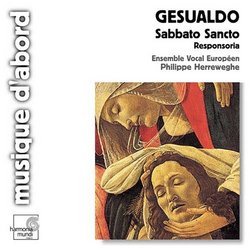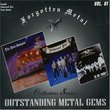| All Artists: Carlo Gesualdo, Sandro Gorli Title: Gesualdo: Sabbato Sancto; Responsoria Members Wishing: 0 Total Copies: 0 Label: Harmonia Mundi Fr. Release Date: 4/12/2005 Album Type: Import Genre: Classical Styles: Opera & Classical Vocal, Historical Periods, Early Music Number of Discs: 1 SwapaCD Credits: 1 UPC: 794881766024 |
Search - Carlo Gesualdo, Sandro Gorli :: Gesualdo: Sabbato Sancto; Responsoria
CD DetailsSimilar CDs
|
CD ReviewsFresh Prince of Polyphony Giordano Bruno | Wherever I am, I am. | 04/19/2008 (5 out of 5 stars) "I've been searching for a superlative performance of the music of Carlo Gesualdo (1560-1613), and now I've found one, right in my own CD collection, purchased at least 15 years ago but still sealed and therefore never played. This CD is a welcome reissue of the one I have.
Gesualdo has become an almost mythical figure - the mad Italian prince who murdered his wife and her lover, and who wrote music that wouldn't be appreciated until the 20th Century. Like most myths, this one is nonsense based on facts. Gesualdo was a prince, with the fiscal resources to live his life as he chose, and he chose to compose. He did murder his adulterous wife in 1590, or hired thugs to do it, and fled to his castle in Venosa, not to flee the law but to escape a possible vendetta. His peers probably thought that the murder was necessary to defend his honor and that the couple got what they deserved. This was in Naples, remember. Just three years later, Gesualdo married again, to a daughter of the elevated D'Este family. For that wedding, he traveled to Ferrara, one of the most active musical cities in Italy, where the composer Luzzasco Luzzaschi was busy composing advanced madrigals for the "Three Ladies", famous virtuoso singers of the Ferrara court. The other myth, that Gesualdo was ahead of his times, is easy to understand upon first hearing his music, which does feature chords and modulations that have the power to surprise even lovers of extreme modernism. Listen longer, and you will recognize that Gesualdo was schooled in the musical language of the Italian madrigalists, who had had taken the emotional temperature of the older Franco-Flemish polyphony into the red zone. In other words, structurally, Gesualdo is not so much different from Palestrina or Lassus. The Prince of Venosa just had the will and the skill to explore the outermost harmonic reaches of Renaissance musical theory. So... Listening to this CD, within a few bars of the first vocal entrance, you'll hear intersections of the vocal lines - chords - that you've never heard in early music before. But the bizarre harmonies Gesualdo uses are not for musical novelty; they're part of his inflamed word painting. The texts of these devotional motets for Sabbato Sancto (Holy Sabbath) are laments over the Crucifixion, the musical match for the picture of the dead Jesus on the CD cover. Flamboyant emotionalism is what sets Gesualdo apart from his peers, not mere dissonances. Philippe Herreweghe and his Ensemble Vocal Europeen have done the nearly impossible. With a choir of fifteen voices, they have achieved the tight ensemble and perfection of tuning of the best one-on-a-part consort. The sound engineer for this CD has also performed a miracle; all those voices sound utterly human! Distortion is minimal; presence is intimate. Herreweghe is principally a Baroque specialist, whose ventures into Renaissance territory aren't always graceful, but this Gesualdo is a triumph. The last five tracks of the CD are devoted to a Requiem by the modern composer Sandro Gorli, born in 1948. This Requiem is also an a capella choral piece, ever so similar to Gesualdo in emotional affect yet radically new in musical structure. Just listen to the two in juxtaposition, and I'm sure you'll realize how thoroughly a 16th C composer Gesualdo was. This Requiem is not included merely for contrast, however. Sandro Gorli can write! His Requiem is succinct, tonally beautiful, and quite moving, even after your emotional core has been shaken by Do Carlo." |



